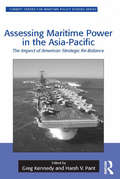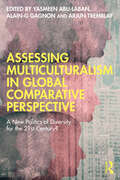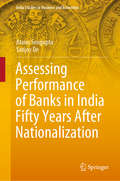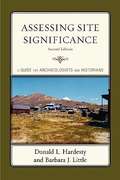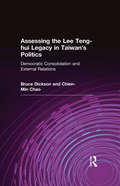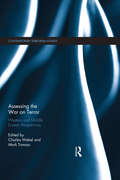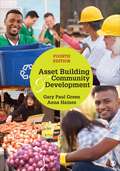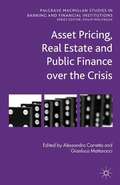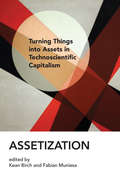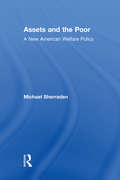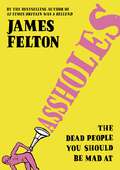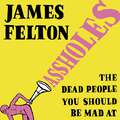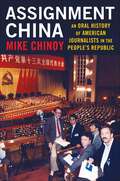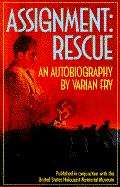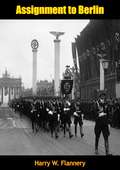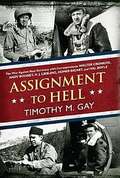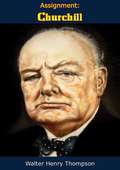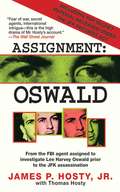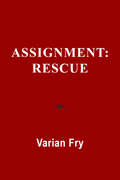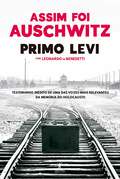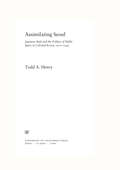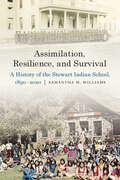- Table View
- List View
Assessing Maritime Power in the Asia-Pacific: The Impact of American Strategic Re-Balance (Corbett Centre for Maritime Policy Studies Series)
by Greg Kennedy Harsh V. PantLeading academics from around the world, who specialize in analysing maritime strategic issues, deliberate the impact of the American 'pivot' or 're-balance' strategy, and the 'Air-Sea Battle' operational concept, on the maritime power and posture of a number of selected states. Intending to strengthen US economic, diplomatic, and security engagement throughout the Asia-Pacific, both bilaterally and multilaterally, the re-balance stands out as one of the Obama administration's most far-sighted and ambitious foreign policy initiatives.
Assessing Multiculturalism in Global Comparative Perspective: A New Politics of Diversity for the 21st Century?
by Yasmeen Abu-Laban, Alain-G Gagnon and Arjun TremblayIn Assessing Multiculturalism in Global Comparative Perspective, a group of leading scholars come together in a multidisciplinary collection to assess multiculturalism through an international comparative perspective. Multiculturalism today faces challenges like never before, through the concurrent rise of populism and white supremacist groups, and contemporary social movements mobilizing around alternative ideas of decolonization, anti-racism and national self-determination Taking these challenges head on, and with the backdrop that the term multiculturalism originated in Canada before going global, this collection of chapters presents a global comparative view of multiculturalism, through both empirical and normative perspectives, with the overarching aim of comprehending multiculturalism’s promise, limitations, contemporary challenges, trajectory and possible futures. Collectively, the chapters provide the basis for a critical assessment of multiculturalism’s first 50 years, as well as vital insight into whether multiculturalism is best equipped to meet the distinct challenges characterizing this juncture of the 21st century. With coverage including the Americas, Europe, Oceania, Africa and Asia, and thematic coverage of citizenship, religion, security, gender, Black Lives Matter and the post-pandemic order, Assessing Multiculturalism in Global Comparative Perspective presents a comprehensively global collection that is indispensable reading for scholars and students of diversity in the 21st century.
Assessing Performance of Banks in India Fifty Years After Nationalization (India Studies in Business and Economics)
by Atanu Sengupta Sanjoy DeThis book assesses the performance of banks in India over the past several decades, and discusses their current status after fifty years of nationalization. The performance of different categories of banks is evaluated by employing both the traditional ratio analysis and more sophisticated efficiency techniques. The book also explores the market conditions under which Indian banks operate. Going beyond a formal banking study, the book also investigates the causes of the widespread presence of informal credit in parallel to its formal banking counterpart. This approach makes it more comprehensive, unique and closer to the real world.After 50 years of nationalization, India’s banking sector is at a crossroads, given the huge and unabated non-performing assets and talks of consolidation. This book, encompassing both the formal and the predominantly ‘trust-based’ informal credit system, provides essential insights for bankers and policymakers, which will be invaluable in their endeavours to implement meaningful changes. It may also spark new research in the fields of banking performance and efficiency analysis. Lastly, the book not only has significant implications for students of economics, banking, finance and management, but also offers an important resource to support training courses for banking personnel in India.
Assessing Site Significance: A Guide for Archaeologists and Historians (Second Edition)
by Donald L. Hardesty Barbara J. LittleAssessing Site Significance is an invaluable resource for archaeologists and others who need guidance in determining whether sites are eligible for listing in the National Register of Historic Places (NRHP). Because the register's eligibility criteria were largely developed for standing sites, it is difficult to know in any particular case whether a site known primarily through archaeological work has sufficient 'historical significance' to be listed. Hardesty and Little address these challenges, describing how to file for NRHP eligibility and how to determine the historical significance of archaeological properties. This second edition brings everything up to date, and includes new material on 17th- and 18th-century sites, traditional cultural properties, shipwrecks, Japanese internment camps, and military properties.
Assessing the Lee Teng-hui Legacy in Taiwan's Politics: Democratic Consolidation and External Relations (Taiwan In The Modern World Ser.)
by Chien-Min Chao Bruce DicksonThe 12 years of Lee Teng-hui's presidency were marked by a series of contrary trends such as progress in the consolidation of Taiwan's democracy, and periodic conflicts with China. This book assesses the complex legacy of Lee Teng-hui by looking at his accomplishments and setbacks.
Assessing the War on Terror: Western and Middle Eastern Perspectives (Contemporary Terrorism Studies)
by Charles Webel Mark TomassThis volume is a collection of articles that critically examine the efficacy, ethics, and impact of the War on Terror as it has evolved since 9/11. During the decade and a half of the Global War on Terror (GWOT), numerous books have considered the political, psychosocial, and economic impacts of terrorism. However, there has been little systematic effort to examine the effectiveness of the GWOT in achieving its goals. Furthermore, there is virtually nothing that presents a comparative analysis of the GWOT by the people most directly affected by it—citizens and scholars from conflict zones in the Middle East. There is, therefore, great need for a book that analyzes the strategies, tactics, and outcomes of the GWOT and that also presents facts and ideas that are missing or underrepresented in the dominant public narratives. The contributions in this volume were chosen to specifically address this need. In doing so, it uniquely provides not only Western perspectives of the GWOT, but also importantly includes perspectives from the Middle East and those most directly affected by it, including contributions from scholars and policy makers. Overall, the contributions demonstrate how views differ based on geographical location, and how views have changed during the course of the still-evolving War on Terror. The book will be of much interest to students and scholars of terrorism and counter-terrorism, foreign policy, Middle Eastern politics, security studies and IR, as well as policy makers.
Assessment of Agent Monitoring Strategies for the Blue Grass and Pueblo Chemical Agent Destruction Pilot Plants
by Committee on Assessment of Agent Monitoring Strategies for the Blue Grass Pueblo Chemical Agent Destruction Pilot PlantsJanuary 2012 saw the completion of the U. S. Army's Chemical Materials Agency's (CMA's) task to destroy 90 percent of the nation's stockpile of chemical weapons. CMA completed destruction of the chemical agents and associated weapons deployed overseas, which were transported to Johnston Atoll, southwest of Hawaii, and demilitarized there. The remaining 10 percent of the nation's chemical weapons stockpile is stored at two continental U. S. depots, in Lexington, Kentucky, and Pueblo, Colorado. Their destruction has been assigned to a separate U. S. Army organization, the Assembled Chemical Weapons Alternatives (ACWA) Element. ACWA is currently constructing the last two chemical weapons disposal facilities, the Pueblo and Blue Grass Chemical Agent Destruction Pilot Plants (denoted PCAPP and BGCAPP), with weapons destruction activities scheduled to start in 2015 and 2020, respectively. ACWA is charged with destroying the mustard agent stockpile at Pueblo and the nerve and mustard agent stockpile at Blue Grass without using the multiple incinerators and furnaces used at the five CMA demilitarization plants that dealt with assembled chemical weapons - munitions containing both chemical agents and explosive/propulsive components. The two ACWA demilitarization facilities are congressionally mandated to employ noncombustion-based chemical neutralization processes to destroy chemical agents. In order to safely operate its disposal plants, CMA developed methods and procedures to monitor chemical agent contamination of both secondary waste materials and plant structural components. ACWA currently plans to adopt these methods and procedures for use at these facilities. The Assessment of Agent Monitoring Strategies for the Blue Grass and Pueblo Chemical Agent Destruction Pilot Plants report also develops and describes a half-dozen scenarios involving prospective ACWA secondary waste characterization, process equipment maintenance and changeover activities, and closure agent decontamination challenges, where direct, real-time agent contamination measurements on surfaces or in porous bulk materials might allow more efficient and possibly safer operations if suitable analytical technology is available and affordable.
Asset Building Community Development Fourth Edition
by Gary Paul Green Anna HainesAsset Building and Community Development, Fourth Edition examines the promise and limits of community development by showing students and practitioners how asset-based developments can improve the sustainability and quality of life. Authors Gary Paul Green and Anna Haines provide an engaging, thought-provoking, and comprehensive approach to asset building by focusing on the role of different forms of community capital in the development process. Updated throughout, this edition explores how communities are building on their key assets—physical, human, social, financial, environmental, political, and cultural capital— to generate positive change. With a focus on community outcomes, the authors illustrate how development controlled by community-based organizations provides a better match between assets and the needs of the community.
Asset Pricing, Real Estate and Public Finance over the Crisis
by Alessandro Carretta Gianluca MattarocciThe current financial crisis started from the US real estate market and after, though the increase of risk premium requested by investors and due to the lack of liquidity of all financial markets, it became a world financial crisis. A detailed analysis during the crisis focuses attention on asset management, the real estate and public sector.
Assetization: Turning Things into Assets in Technoscientific Capitalism (Inside Technology)
by Kean Birch Fabian MuniesaHow the asset--anything that can be controlled, traded, and capitalized as a revenue stream--has become the primary basis of technoscientific capitalism.In this book, scholars from a range of disciplines argue that the asset--meaning anything that can be controlled, traded, and capitalized as a revenue stream--has become the primary basis of technoscientific capitalism. An asset can be an object or an experience, a sum of money or a life form, a patent or a bodily function. A process of assetization prevails, imposing investment and return as the key rationale, and overtaking commodification and its speculative logic. Although assets can be bought and sold, the point is to get a durable economic rent from them rather than make a killing on the market.
Assets and the Poor: New American Welfare Policy
by Neil Gilbert Michael SherradenThis work proposes a new approach to welfare: a social policy that goes beyond simple income maintenance to foster individual initiative and self-sufficiency. It argues for an asset-based policy that would create a system of saving incentives through individual development accounts (IDAs) for specific purposes, such as college education, homeownership, self-employment and retirement security. In this way, low-income Americans could gain the same opportunities that middle- and upper-income citizens have to plan ahead, set aside savings and invest in a more secure future.
Assholes
by James FeltonIn this, er, 'unique' illustrated potted history of the human race, Twitter icon James Felton uses his inimitable brand of banter to unveil the slyest, creepiest and/or nastiest specimens who've ever lived.Enter the 16th Century Chinese Emperor Zhegende, whose harem was so big some of the women within it died of starvation, King Charles II's executioner who would only give you a clean beheading if you paid properly for it beforehand, and llya Ivanovich Ivanov, the 19th Century scientist who was a mega asshole and if you buy the book you'll find out why.Darkly funny, highly informative and always unbelievable, these are the dead people you should be mad at.
Assholes
by James FeltonIn this, er, 'unique' illustrated potted history of the human race, Twitter icon James Felton uses his inimitable brand of banter to unveil the slyest, creepiest and/or nastiest specimens who've ever lived.Enter the 16th Century Chinese Emperor Zhegende, whose harem was so big some of the women within it died of starvation, King Charles II's executioner who would only give you a clean beheading if you paid properly for it beforehand, and llya Ivanovich Ivanov, the 19th Century scientist who was a mega asshole and if you buy the book you'll find out why.Darkly funny, highly informative and always unbelievable, these are the dead people you should be mad at.
Assholes
by James FeltonRead by Russell KaneIn this, er, 'unique' illustrated potted history of the human race, Twitter icon James Felton uses his inimitable brand of banter to unveil the slyest, creepiest and/or nastiest specimens who've ever lived.Enter the 16th Century Chinese Emperor Zhegende, whose harem was so big some of the women within it died of starvation, King Charles II's executioner who would only give you a clean beheading if you paid properly for it beforehand, and llya Ivanovich Ivanov, the 19th Century scientist who was a mega asshole and if you buy the book you'll find out why.Darkly funny, highly informative and always unbelievable, these are the dead people you should be mad at.
Assignment China: An Oral History of American Journalists in the People's Republic
by Mike ChinoyReporting on China has long been one of the most challenging and crucial of journalistic assignments. Foreign correspondents have confronted war, revolution, isolation, internal upheaval, and onerous government restrictions as well as barriers of language, culture, and politics. Nonetheless, American media coverage of China has profoundly influenced U.S. government policy and shaped public opinion not only domestically but also, given the clout and reach of U.S. news organizations, around the world.This book tells the story of how American journalists have covered China—from the civil war of the 1940s through the COVID-19 pandemic—in their own words. Mike Chinoy assembles a remarkable collection of personal accounts from eminent journalists, including Stanley Karnow, Seymour Topping, Barbara Walters, Dan Rather, Melinda Liu, Nicholas Kristof, Joseph Kahn, Evan Osnos, David Barboza, Amy Qin, and Megha Rajagopalan, among dozens of others. They share behind-the-scenes stories of reporting on historic moments such as Richard Nixon’s groundbreaking visit in 1972, China’s opening up to the outside world and its emergence as a global superpower, and the crackdowns in Tiananmen Square and Xinjiang. Journalists detail the challenges of covering a complex and secretive society and offer insight into eight decades of tumultuous political, economic, and social change.At a time of crisis in Sino-American relations, understanding the people who have covered China for the American media and how they have done so is crucial to understanding the news. Through the personal accounts of multiple generations of China correspondents, Assignment China provides that understanding.
Assignment Rescue: An Autobiography
by Varian FryThe Gestapo's blacklist was thousands of names long.... How many people could he get out before Hitler sealed the frontiers? Varian Fry didn't know any more about being an undercover agent than what he'd seen in the movies. But he was the one man who could get into Vichy France, where thousands of people had fled Hitler's Germany. Unless he could get them out, they'd be trapped--turned back to the concentration camps and death camps. An exciting, true story of World War II--Varian Fry describes the methods he used to get thousands of hunted men and women to safety.
Assignment to Berlin
by Harry W. FlanneryBy the man who succeeded William L. Shirer as the Berlin correspondent of the Columbia Broadcasting System, Assignment to Berlin by U.S. journalist and author Harry W. Flannery, first published in 1942, covers Germany in the crucial year 1941.Packed with lively incident, shrewd comment and startling information, it brings the story of life in Hitler’s domain up to the eve of America’s entry into the war.
Assignment to Hell: The War Against Nazi Germany with Correspondents Walter Cronkite, Andy Rooney, A. J. Liebling, Homer Bigart, and Hal Boyle
by Timothy M. GayTHEIR WORK ON THE FRONT LINES MADE HEADLINES In February 1943, a group of journalists—including a young wire service correspondent named Walter Cronkite and cub reporter Andy Rooney—clamored to fly along on a bombing raid over Nazi Germany. Seven of the sixty-four bombers that attacked a U-boat base that day never made it back to England. A fellow survivor, Homer Bigart of the New York Herald Tribune, asked Cronkite if he’d thought through a lede. “I think I’m going to say,” mused Cronkite, “that I’ve just returned from an assignment to hell. ” During his esteemed career Walter Cronkite issued millions of words for public consumption, but he never wrote or uttered a truer phrase. Assignment to Hell tells the powerful and poignant story of the war against Hitler through the eyes of five intrepid reporters. Crisscrossing battlefields, they formed a journalistic band of brothers, repeatedly placing themselves in harm’s way to bring the war home for anxious American readers. Cronkite crashed into Holland on a glider with U. S. paratroopers. Rooney dodged mortar shells as he raced across the Rhine at Remagen. Behind enemy lines in Sicily, Bigart jumped into an amphibious commando raid that nearly ended in disaster. The New Yorker’s A. J. Liebling ducked sniper fire as Allied troops liberated his beloved Paris. The Associated Press’s Hal Boyle barely escaped SS storm troopers as he uncovered the massacre of U. S. soldiers during the Battle of the Bulge. Assignment to Hell is a stirring tribute to five of World War II’s greatest correspondents and to the brave men and women who fought on the front lines against fascism—their generation’s “assignment to hell. ” .
Assignment: Churchill
by Walter Henry ThompsonAN UNIQUE, INTIMATE VIEW OF WINSTON CHURCHILL BY THE MAN WHO GUARDED HIM NIGHT AND DAY FOR 20 MOMENTOUS YEARS.When Tommy Thompson as assigned to guard Winston Churchill by Scotland Yard he shuddered. Churchill was considered a tough assignment and Thompson had had his share of tough ones. From Lloyd George to King Alexander of Yugoslavia. But he did it for almost 20 years.Here is a delightful intimate view of the great statesman and his contemporaries—Lawrence of Arabia, F.D.R., Joseph Stalin, seen with the well-trained eye of a Scotland Yard man.“As intimate a portrait of Churchill as has ever been committed to print.”—San Francisco Chronicle“A supremely colorful man, chewing on his dead cigars striking matches on the walls of the kremlin parading naked before an embarrassed President Roosevelt—indifferent to the lesser things in life, but never missing the main chances of his destiny.”—New York Times“Gripping...Churchill’s biographers will unquestionably have to draw on this book by the officer who was the great man’s shadow for 20 years.”—Saturday Review Syndicate“If it’s suspense and excitement you seek in a book...just read ASSIGNMENT: CHURCHILL.”—Los Angeles Times
Assignment: Oswald
by Thomas Hosty James P. HostySpecial Agent James Hosty began investigating Lee Harvey Oswald in October 1963, a full month before the JFK assassination. From November 22 on, Hosty watched as everyone from the Dallas Police, the FBI, the CIA, Naval Intelligence, and the State Department up through the Warren Commission to J. Edgar Hoover, Robert Kennedy, and Lyndon Johnson reacted to and manipulated the facts of the president's assassination--until Hosty himself became their scapegoat. After seeing his name appear in three inconclusive federal investigations and countless fact-twisting conspiracy theories (including Oliver Stone's motion picture), Hosty decided to tell his own story.Assignment: Oswald is the authoritative insider's account of one of our country's most traumatic events. Combining his own unique, intimate knowledge of the case with previously unavailable government documents--including top secret CIA files recently released from the National Archives--Hosty tells the true story behind the assassination and the government's response to it, including the suppression of a documented Oswald-Soviet-Castro connection. Hosty offers an exclusive insider's knowledge of the mechanisms, the power structures, and the rivalries in and among the various intelligence and law enforcement agencies and why they have determined who knows what about the assassination. Here, at last, is an unmistakably expert and responsible account of the murder of President Kennedy.
Assignment: Rescue
by Albert O. Hirschman Varian FryMarseilles, France...August, 1940 The Gestapo's blacklist was thousands of names long...How many people could he get out before Hitler sealed the frontiers? Varian Fry didn't know any more about being an undercover agent than what he'd seen in the movies. But, he was the one man who could get into Vichy France, where thousands of people had fled Hitler's Germany. Unless he could get them out, they'd be trapped-turned back to the concentration camps and death camps. An exciting, true story of World War II - Varian Fry describes the methods he used to get thousands of hunted men and women to safety.
Assim foi Auschwitz
by Primo LeviTestemunho inédito de uma das vozes mais relevantes da memória do Holocausto. «Somos homens, pertencemos à mesma família humana a que pertencem os nossos carrascos. [...] Somos filhos dessa Europa onde está Auschwitz.» Em 1945, no rescaldo do fim da Guerra e da libertação dos campos de concentração pelas forças aliadas, o exército soviético pediu a Primo Levi e a Leonardo De Benedetti, seu companheiro de campo, que redigissem uma relação pormenorizada das condições de vida nos Lager. O resultado foi um dos primeiros relatórios alguma vez realizados sobre os campos de extermínio. Chocante pela objectividade e detalhe, tocante pela precoce e indignada lucidez, é um testemunho extraordinário daquela que viria a ser uma das vozes mais relevantes da antologia de memórias sobre o Holocausto. Assim foi Auschwitz recolhe esse relatório e vários outros textos de Primo Levi - inéditos até hoje - sobre a experiência colectiva do Holocausto, compondo um mosaico de memórias e reflexões críticas de inestimável valor histórico e humano, tão relevantes hoje, setenta anos volvidos sobre o fim da Segunda Guerra, como no tempo em que foram escritos. «A nossa esperança é que tudo o que aqui foi documentado seja visto e lembrado como uma aberração a não repetir até ao futuro mais longínquo. A esperança de todos os homens é que estas imagens sejam vistas como um fruto horrendo, mas isolado, da tirania e do ódio: que se identifiquem as suas raízes na grande parte da história sangrenta da Humanidade, mas que o fruto não dê novas sementes,nem amanhã nem nunca.»
Assim foi Auschwitz
by Primo LeviTestemunho inédito de uma das vozes mais relevantes da memória do Holocausto. FORMATO DE BOLSO, NUMA EDIÇÃO CUIDADA (CAPA DURA). Em 1945, no rescaldo do fim da Guerra e da libertação dos campos de concentração pelas forças aliadas, o exército soviético pediu a Primo Levi e a Leonardo De Benedetti, seu companheiro de campo, que redigissem uma relação pormenorizada das condições de vida nos Lager. O resultado foi um dos primeiros relatórios alguma vez realizados sobre os campos de extermínio. Chocante pela objectividade e detalhe, tocante pela precoce e indignada lucidez, é um testemunho extraordinário daquela que viria a ser uma das vozes mais relevantes da antologia de memórias sobre o Holocausto.Assim foi Auschwitz recolhe esse relatório e vários outros textos de Primo Levi - inéditos até hoje - sobre a experiência colectiva do Holocausto, compondo um mosaico de memórias e reflexões críticas de inestimável valor histórico e humano, tão relevantes hoje, setenta anos volvidos sobre o fim da Segunda Guerra, como no tempo em que foram escritos. «A nossa esperança é que tudo o que aqui foi documentado seja visto e lembrado como uma aberração a não repetir até ao futuro mais longínquo. A esperança de todos os homens é que estas imagens sejam vistas como um fruto horrendo, mas isolado, da tirania e do ódio: que se identifiquem as suas raízes na grande parte da história sangrenta da Humanidade, mas que o fruto não dê novas sementes,nem amanhã nem nunca.»
Assimilating Seoul
by Todd A. HenryAssimilating Seoul, the first book-length study written in English about Seoul during the colonial period, challenges conventional nationalist paradigms by revealing the intersection of Korean and Japanese history in this important capital. Through microhistories of Shinto festivals, industrial expositions, and sanitation campaigns, Todd A. Henry offers a transnational account that treats the city's public spaces as "contact zones," showing how residents negotiated pressures to become loyal, industrious, and hygienic subjects of the Japanese empire. Unlike previous, top-down analyses, this ethnographic history investigates modalities of Japanese rule as experienced from below. Although the colonial state set ambitious goals for the integration of Koreans, Japanese settler elites and lower-class expatriates shaped the speed and direction of assimilation by bending government initiatives to their own interests and identities. Meanwhile, Korean men and women of different classes and generations rearticulated the terms and degree of their incorporation into a multiethnic polity. Assimilating Seoul captures these fascinating responses to an empire that used the lure of empowerment to disguise the reality of alienation.
Assimilation, Resilience, and Survival: A History of the Stewart Indian School, 1890–2020 (Indigenous Education)
by Samantha M. WilliamsAssimilation, Resilience, and Survival illustrates how settler colonialism propelled U.S. government programs designed to assimilate generations of Native children at the Stewart Indian School (1890–1980). The school opened in Carson City, Nevada, in 1890 and embraced its mission to destroy the connections between Native children and their lands, isolate them from their families, and divorce them from their cultures and traditions. Newly enrolled students were separated from their families, had their appearances altered, and were forced to speak only English. However, as Samantha M. Williams uncovers, numerous Indigenous students and their families subverted school rules, and tensions arose between federal officials and the local authorities charged with implementing boarding school policies. The first book on the history of the Stewart Indian School, Assimilation, Resilience, and Survival reveals the experiences of generations of Stewart School alumni and their families, often in their own words. Williams demonstrates how Indigenous experiences at the school changed over time and connects these changes with Native American activism and variations in federal policy. Williams&’s research uncovers numerous instances of abuse at Stewart, and Assimilation, Resilience, and Survival addresses both the trauma of the boarding school experience and the resilience of generations of students who persevered there under the most challenging of circumstances.
